ASUS N53JF: Midrange 15.6” 1080p, Take Four
by Jarred Walton on December 28, 2010 1:40 AM ESTThe N53JF’s LCD: Not Up to Snuff
After going three-for-three on 1080p 15.6” LCDs being good quality, the ASUS notebook sadly ends our streak. Maximum brightness is just above 200nits, which isn’t too good if you’re trying to use it outdoors. The contrast is even worse, checking in at 233:1. We’ve seen plenty of laptops with even worse contrast ratios, but none of them were 1080p LCDs. Color accuracy is at least decent, and color gamut in some respects is better suited to general use than the high gamut displays. We’ve added the sRGB percentage of the Adobe 1998 color space to illustrate this point: 69% of ARGB is basically “ideal” for sRGB use, though in practice I still prefer slightly higher gamuts. Apple’s 77% is probably optimal for casual users.
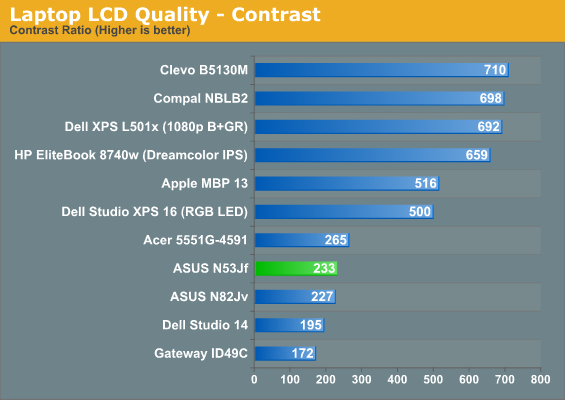
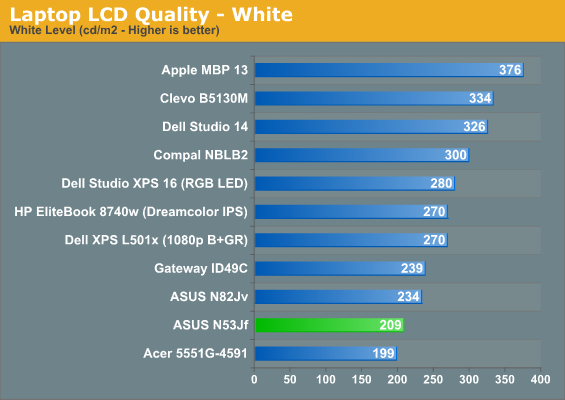
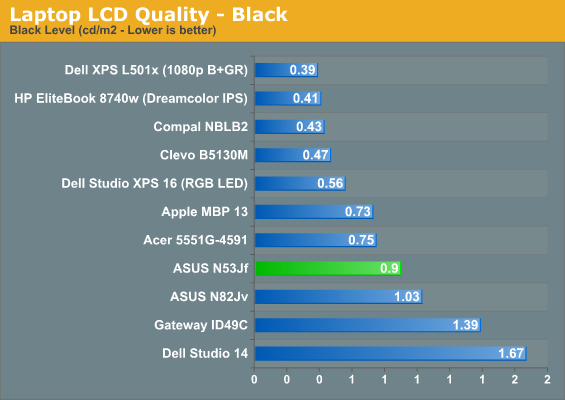
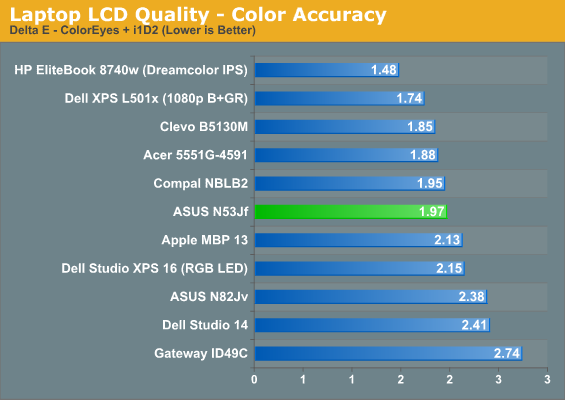
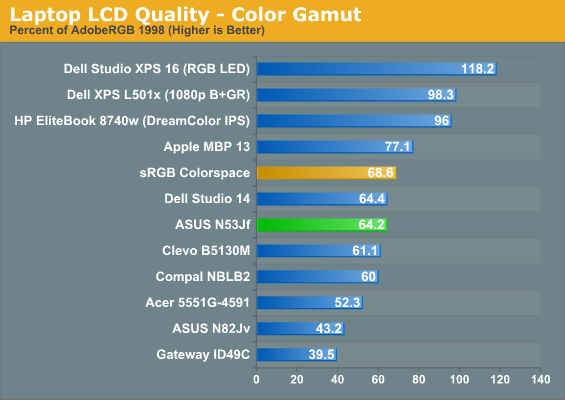
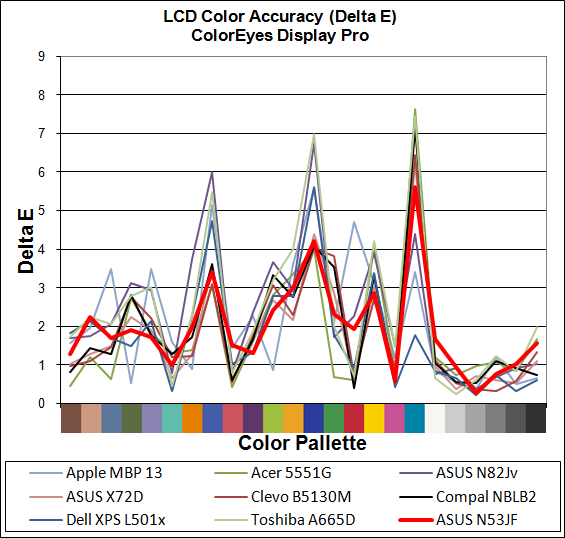
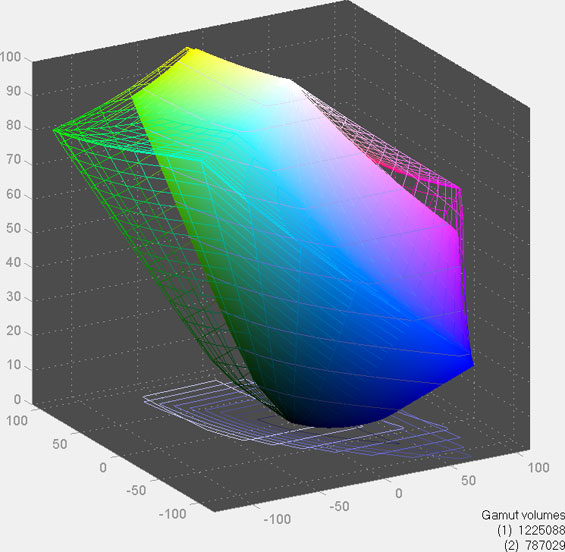
Viewing angles are standard TN panel fare, with severe color shifts from above and below. Nothing new to report here.
Heat and Noise Levels

Using our standard stress test of 3DMark06 looping (with some x264 encoding running in the background), final system temperatures hit 82C on the CPU and 67C on the GPU. (ACPI reports a temperature of 88C, but I’m not sure what that’s measuring or if it’s accurate.) Surface temperatures are also fine and are similar to the other midrange notebooks we’ve tested. Idle temps ranged from 25-28C on the palm rest and keyboard, while the bottom is slightly warmer at 25-31C. Under our stress test, the top surfaces hit 25-32C and the bottom 25-38C, with the hottest areas near on the exhaust on the left side. Noise levels are also decent, with idle noise near the 30dB floor of our test equipment and environment but coming in just above that with 31dB; load noise is particularly good, reaching a maximum of just 36dB (measured from 12” in front of the notebook).
















65 Comments
View All Comments
visibilityunlimited3 - Wednesday, December 29, 2010 - link
I had problems with my eyes looking at an 14" XGA. I almost went blind before I got my 15.4" Inspiron 1920x1200 screen many years later. My eyes have fewer problems after looking at that high resolution display for many years now.Consider the difference between old dot matrix printers and laser printers. Is reading 1200dpi text uncomfortable? The real problem is Windows being optimized for low res screens. There are a few configuration changes that can help. I actually dual boot with Windows XP and Debian and prefer the Debian for being better equipped to manage the high resolution display. I spent a little extra time fine tuning the X Window System to do exactly what I wanted and I am very comfortable now. I am in no hurry to downgrade to the 1080p display until my old Pentium M gets really tired. The display is that much more important than anything else in my opinion. Thanks Jarred for recognizing the value of the premium displays.
I would like an ebook reader with 1200dpi resolution to match my laser printer and expect that would be very comfortable to use also.
Davelo - Tuesday, December 28, 2010 - link
How many laptops have went bad because of bad BGA solder of Nvidia chips? I've seen so many I would not touch one.DanNeely - Tuesday, December 28, 2010 - link
Weren't those all the first generation lead-free BGA chips? I didn't think any of the newer ones were having problems.JarredWalton - Tuesday, December 28, 2010 - link
Yeah, this is old news. A few anti-NVIDIA sites made a huge deal about the failures, but I never personally had any of those chips fail on me. Of course, I wasn't playing a lot of games on laptops, so maybe that's why. Anyway, anything in the post-8000M era should definitely be fine. Actually, I think it was mostly the old GeForce Go series that had problems.sucram03 - Tuesday, December 28, 2010 - link
Somewhat on & off-topic question: So in all honesty, with such a horrendous screen, where does that leave value-minded users that want a laptop with a nice 1080p screen and a GeForce video card? The application I'm thinking of is CUDA-accelerating H.264/AVC 1080p videos.The XPS 15 isn't listing the B+RG LED as an option, as mentioned in the article. Has anyone else heard from Dell about reasons why/if it will come back? The Clevo seems like an OK option but... well.. it now seems like the only option.
Any thoughts?
JarredWalton - Tuesday, December 28, 2010 - link
At this point, I'd say just wait for the CES announcements and see if anything new turns up. :-)Kaboose - Tuesday, December 28, 2010 - link
Could Dell be holding back the 1080p panels for a sandy laptop in the next few weeks?sucram03 - Tuesday, December 28, 2010 - link
All signs point to yes, especially that suspect smiley face from Jared :) Damn you insider knowledge!Kaboose - Tuesday, December 28, 2010 - link
thank goodness i have been saving up for the past two months in anticipation of sandy bridge and my need for a new portable computer. luckily they coincide.JarredWalton - Tuesday, December 28, 2010 - link
I've got Sandy Bridge, but I have no idea if Dell is holding back panels. I sure hope so...